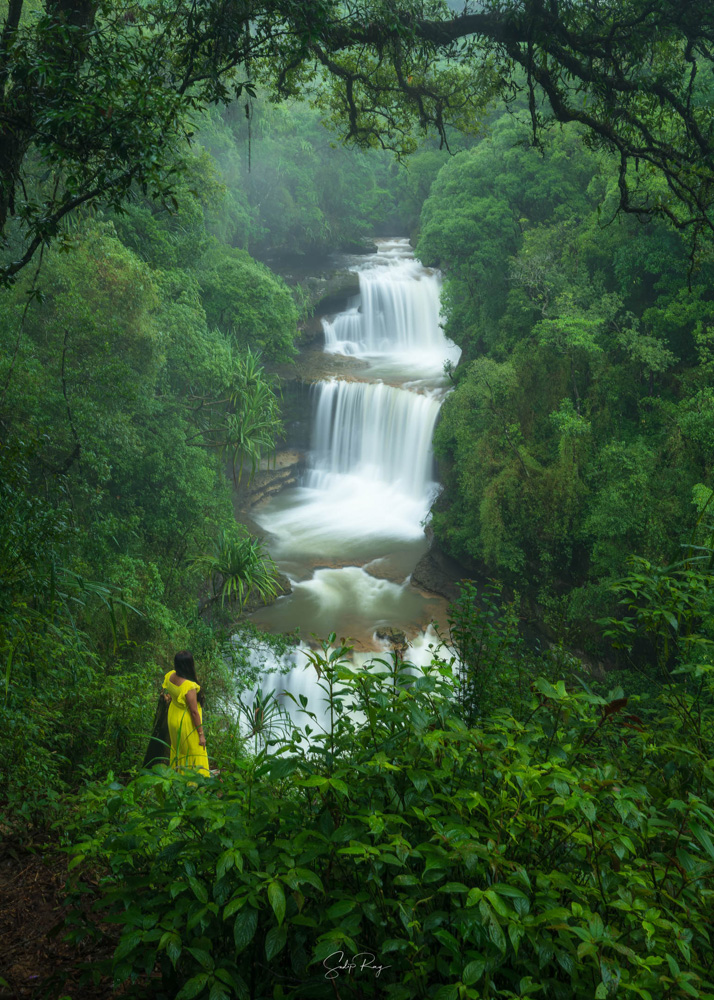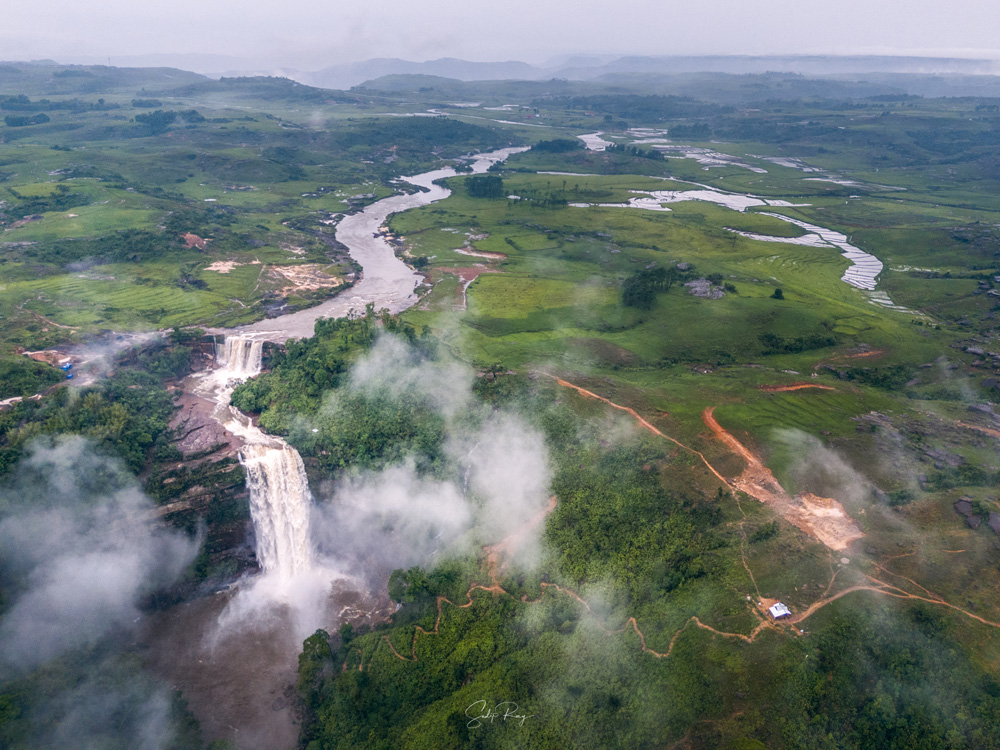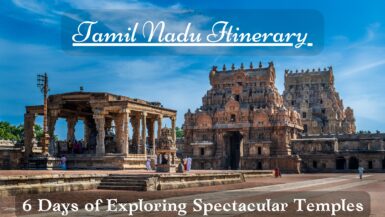Meghalaya, widely known as the ‘Abode of Clouds’, is home to numerous phenomenal waterfalls which are also among the most picturesque in India. Meghalaya’s unique geography with high rainfall and hilly terrain creates the ideal conditions for these splendid waterfalls. At every bend of the road, you will come across a waterfall more spectacular than the previous one.

Meghalaya’s waterfalls are not only nature’s wonders but also hold spiritual and cultural significance for the local communities. Each waterfall has a story of its own, woven into the tapestry of the region’s heritage. Hiking through the dense forests and rolling hills to reach these rippling marvels adds to the adventures, offering a glimpse into Meghalaya’s rich bio-diversity and unique tribal heritage.
In this blog, we have enlisted those 12 waterfalls of Meghalaya, which literally took our breath away.
Table of Contents
1. Nohkalikai Falls:
Arguably the most popular waterfall in Meghalaya, Nohkalikai Falls is the tallest plunge waterfall in India and the fourth highest in the world. Descending from a jaw-dropping height of 340 meters/1,115 feet, this natural wonder is a sight to behold. You will be surely left speechless at the very first sight of Nohkalikai.
A haunting local legend of a bereaved mother adds to the mystical charm of this place. In the local tongue, the word ‘Nohkalikai’ translates to ‘jump of Ka Likai’. According to the legend, a widowed Khasi woman named Ka Likai lived with her infant daughter in a village near the falls. She remarried with the hope of providing her dear daughter with a father figure. In order to provide for her family, Ka Likai worked hard as a porter. But her arduous job required her to often stay away from her home. Whatever little time she could spend at home, she devoted the same to taking care of her child. This filled her second with rage and jealousy.

In a fit of anger, he one day hacked his stepdaughter to death. The wicked man even cooked the remains of the corpse. When Ka Likai returned home, she found her home empty although a cooked meal was awaiting her. Tired and famished, she devoured the food without a second thought. Afterwards, she went to savour a betel nut only to find a severed little finger lying in the basket of betel nut. Shocked and horrified, the truth dawned upon Ka Likai. Dismayed and grief-stricken, she ran madly while swinging a hatchet in her hand. Finally, she took her own life by jumping off the cliff of the plunging waterfalls.

In short, the Nohkalikai Falls is poignantly beautiful. Surrounded by the vibrant greenery of the East Khasi Hills, the gushing water has created a greenish pool at the bottom. The cascading stream frequently plays hide and seek with the floating clouds thereby creating an unforgettable scenery. The Nohkalikai Falls looks particularly exceptional during the sunset.
2. Seven Sisters Falls:
The Seven Sisters Falls is another top draw of Meghalaya. It is formally called the Nohsngthiang Falls. Located near the Mawsamai village, this striking fall is also known as Mawsamai Falls.
The Seven Sisters plummets from a dizzying height of 315 meters/1,033 ft with an average width of 70 meters/240 ft. Ranked as one of the tallest waterfalls in India, the Seven Sisters flow in its full glory only during the monsoon season. Following a spate of monsoon rains, the falls channel its seven streams which nose dive into the thick forest below. The seven streams of Nohsngthiang are said to represent the seven states of northeastern India, hence it received the epithet of Seven Sisters.

Like the Nohkalikai, the Seven Sisters will leave you awestruck. The magnificent sight of the seven rapids gliding down the cliff is simply unforgettable.
3. Wei Sawdong Falls:
In a word, the Wei Sawdong Falls is divine. Our hearts skipped a beat at the very first sight of this heavenly waterfall.
Nestled in lush greenery, the Wei Sawdong is a stunning three-tiered waterfall. In the local Khasi language, the words ‘Wei Sawdong’ means square-shaped pool. The cascading water of the Wei Sawdong creates three natural pools, renowned for their bluish-green water. The pools have crystal clear water in the dry seasons, and they appear as mirrors on the floor of nature’s ground. However, in the monsoon months, the water is somewhat murky.

The trail to reach the Wei Sawdong Falls is a bit difficult, especially during the rainy season. It is located near the Dainthlen Falls.
4. Kynrem Falls:
Tucked away in the lush greenery of the East Khasi Hills, Kynrem Falls is one of the most spectacular waterfalls in Meghalaya. Ranked as the 7th highest waterfall in India, Kynrem lies 17 km away from the main town of Sohra.
The road leading to Kynrem is scenic, punctuated with many rain-fed streams. Kynrem itself is formed by the conjoining of several such smaller rapids. Much like the other waterfalls of Meghalaya, Kynrem’s real avatar is witnessed in the monsoon season.

During the rainy season, Kynrem’s milky white water glides down the rocky edges of the hill in full force. Such is the force of the waterfall’s flow that its water drenches even the spectator standing on the other side of the road. In monsoon, the raw beauty of Kynrem Falls is unrivalled.

5. Phe Phe Falls:
In Jaintia dialect, the word ‘Phe Phe’ means paradise. And truly, the Phe Phe Falls is nothing short of a paradise. It is arguably the most spectacular waterfall of the Jaintia Hills.

Even the road leading to the Phe Phe Falls is as exciting as the falls itself. The dirt road leading to Phe Phe has verdant valleys on both sides. The carpet of greenery is dotted with countless colourful flowers, which indeed is a treat to the eyes. You also need to cross a river to reach the starting point of the hike. As we visited during the monsoon, the river was overflowing and it brought back memories of crossing a truant river in the Zanskar Valley of Ladakh.

The moderate hike to Phe Phe Falls takes around 20-30 minutes. Since it rained heavily the entire day before, Phe Phe was vaulting over the sky-high cliff with all its fury. The scene before us was the exact opposite of what we generally see in the photos of Phe Phe. The volume of water had increased manifold, and the usual calm, blue water of the pool below had turned into a frenzied whirlpool of muddy waters. So much was the force of Phe Phe’s overwhelming flow that all of us were completely drenched by its frantic spray. No raincoat or umbrella could save us, sadly. However, the livid Phe Phe Falls was truly a sight that we will hardly forget.

6. Krang Suri Falls:
If Phe Phe is paradise, then Krang Suri is surely magical. Krang Suri is one of the most picturesque waterfalls in Meghalaya. Stashed in the lap of a thick forest of Jaintia Hills, this charming fall is created when a gentle river springs over a ledge, and thus forms a delicate curtain of rippling water over a cave. The sudden drop, as usual, creates a bluish-green natural pool where visitors revel during the sunny days. However, in the monsoon, going down and swimming is prohibited.

Krang Suri can be reached by a 20-minute hike down the well-constructed stairs. Keep an eye on the surroundings as you will come across an array of flowers, butterflies, spiders, and caterpillars on your way. The path also has a few vantage points from where you can catch a glimpse of the Krang Suri Falls.

7. Thlu Muwi Falls:
The Thlu Muwi waterfall is right on the Jowai – Amlarem road and can be easily spotted from the highway. The attractive falls can be easily reached by a short walk.

There is also a historic stone bridge built by the Jaintia warriors over the Muwi stream. It was constructed to facilitate the Jaintia King to travel from Jaintia to Nartiang.
8. Prut Falls:
Prut is undeniably one of the most gorgeous waterfalls in Meghalaya. The stream of the Wah Urwan River jumps off a hilly cliff to create this dreamy waterfall.

A moderate hike is required to reach the Prut Falls. The hiking trail is as beautiful as the waterfall itself. Surrounded by the verdant slopes of the East Khasi Hills, the dirt path runs through a valley first. The valley is covered by a carpet of green grass and vibrant wildflowers. Eventually, the valley gives way to several craggy steps confined within a thick forest.

The Prut Falls, with its pristine white water cascading down the rock ledges, is a marvel to behold. The gushing water, falling down a height of 40 meters, creates a bluish-green pool at its bottom. Wispy clouds floated here and there, while a host of small streams flowed in the vicinity. Prut is also one of the few waterfalls of Meghalaya, where you can see it from behind the falls.
9. Dainthlen Falls:
Located near the Wei Sadong Falls, Dainthlen is a popular attraction of Cherrapunji. A river flows over the rocky, cratered table land, and leaps over an 80-foot gorge into the dense forest below thus creating the feisty Dainthlen Falls.
The sheer beauty of the Dainthlen Falls can be enjoyed from behind the safety of railings. You need to cross over the stream to relish the best view of these rippling falls. However, it is only possible in the dry season when the water level is next to nil. In the monsoon, the river flows with a strong current.
The Dainthlen Falls is also associated with a Khasi fable. It is said that a colossal serpent named Thlen lived in a cave nearby. The serpent was an evil incarnate, who wreaked havoc and devoured human beings. Finally, Thlen was defeated by the local villagers near the falls and cut to pieces. Henceforth, the waterfalls became renowned as Dainthlen or ‘the place where Thlen was cut’.

10. Lyngksiar Falls:
Lyngkisiar is another phenomenal waterfall of Meghalaya. It is named after a rare orchid with golden petals called Tiew Lyngksiar, which blooms only for three months in the jungle surrounding the waterfall.
The waterfall is created by a series of plunging streams, with two larger courses racing to the ground thus making an expansive pool with sparkling water. The pool’s water takes on the verdant shade of the adjoining thicket.

Previously, the Lyngksiar Falls used to be the fishing ground for the locals. At present, visitors revel by bathing and swimming in its placid water.
11. Diengdoh Falls:
The Diengdoh Waterfalls is located in Mawkama village on the outskirts of the Sohra town. Reaching the falls needs a moderate hike. You need to climb down several stairs amidst a green vale.

Diengdoh is a dainty cascade, prancing over a rocky ledge. The wispy water of Diengdoh resembles a thin veil of sparkling water. Nestled amidst the lush nature, the setting of this waterfall is serene. You will only have the burbling of its dancing water and the chirping of the countless birds for company here.
12. Mawsawdong Falls:
The Diengdoh and Mawsawdong are basically twin waterfalls, standing next to one another.

The rippling water of Mawsawdong leaps over a stepped rock and creates a crystal-clear natural pool at its base. The pool is quite popular among the locals and tourists alike for swimming. Mawsawdong is also one of the few waterfalls of Meghalaya where you can walk behind the stream of flowing water.
Important FAQs:
Where are the waterfalls located in Meghalaya?
Meghalaya is brimming with a bountiful of waterfalls. No wonder, it is often called the ‘Land of the Waterfalls’. Most of the waterfalls are spread in and around Sohra or Cherrapunjee in East Khasi Hills, and Jowai and Amlarem in West Jaintia Hills.
How can I reach Meghalaya?
By air: Meghalaya’s airport is situated at Umroi, 30 km from the city centre of Shillong. Two flights from Kolkata fly to Shillong every day except Sunday. However, the flights often get cancelled due to bad weather.
We would advise taking a direct flight to Guwahati, as they fly regularly on time.
From Guwahati, Shillong is a 3-hour drive (around 100 km).
By train: Guwahati is the nearest rail station to Shillong. You can reach Guwahati by 12345 Saraighat Express, 15959 Kamrup Express, 13181 Kaziranga Express, and 13175 Kanchanjungha Express.
You can get a shared taxi for Shillong from Guwahati’s Paltan Bazar at INR 300-400 per head. You can also book cabs, the price of which varies between INR 3,500 to INR 4,500.

How can I reach Sohra/Cherrapunjee?
Sohra is just 54 km away from the state capital, Shillong. By road, the distance can be covered in 2 hours. However, on weekends and holidays, the road is affected by heavy traffic. So, if you are planning to visit Sohra on weekends and holidays, leave Shillong at the break of dawn.
How can I reach Jowai?
From Shillong, Jowai lies at a distance of around 65 km. It takes around 2.5 hours to reach Jowai from Shillong. Amlarem is another 30 km from Jowai.
What is the best time to visit Meghalaya?
Meghalaya can be visited around the year. But. If your goal is to witness the monsoon magic and waterfalls in their full glory, you ought to plan for the months of June to September. However, take necessary precautions as monsoon rain in Meghalaya is on a whole different level. We visited in the second week of June, and we experienced both rain and sun.

Where can I stay in Sohra/Cherrapunjee?
There is no dearth of hotels in Cherrapunjee. From lavish resorts to simple homestays, you get it all. However, the price of accommodation is substantially hiked during the monsoon and winter months as most tourists flock during this time. Even basic rooms will cost you around INR 3K to 3.5K. While mid-range hotels charge around INR 6.5K to 7K, the price at luxury resorts ranges between INR 12K to 14K.
In Cherrapunjee, you can opt for Polo Orchid Resort, Cherrapunjee Holiday Resort, Jiva Resort, Saimika Resort, and Lamisa Inn.
Where can I stay in Amlarem?
The only reliable hotel in Amlarem is Cord’z Inn Guest House. The rooms are comfortable and provided with basic amenities.
Where can I eat in Sohra/Cherrapunjee?
You can eat in Orange Roots (which is a pure vegetarian restaurant) and Golden Spoon.
Where can I eat in Amlarem?
Kibo restaurant is the only fair option to eat out in Amlarem.
What to pack for monsoon Meghalaya?
Pack quick-dry t-shirts and shorts. Pack extra clothes as you will be surely getting drenched either by rain or a waterfall. Wear hardy, waterproof Crocs and slippers. No need to carry hiking or sports shoes. Carry windcheater jackets that will guard you against both rain and sudden chills. Pack your widest umbrellas, raincoats, and rain ponchos. Don’t forget the hairdryer, as you will need it for drying your hair as well as your bags and equipment. Also, carry a good number of hand towels.



